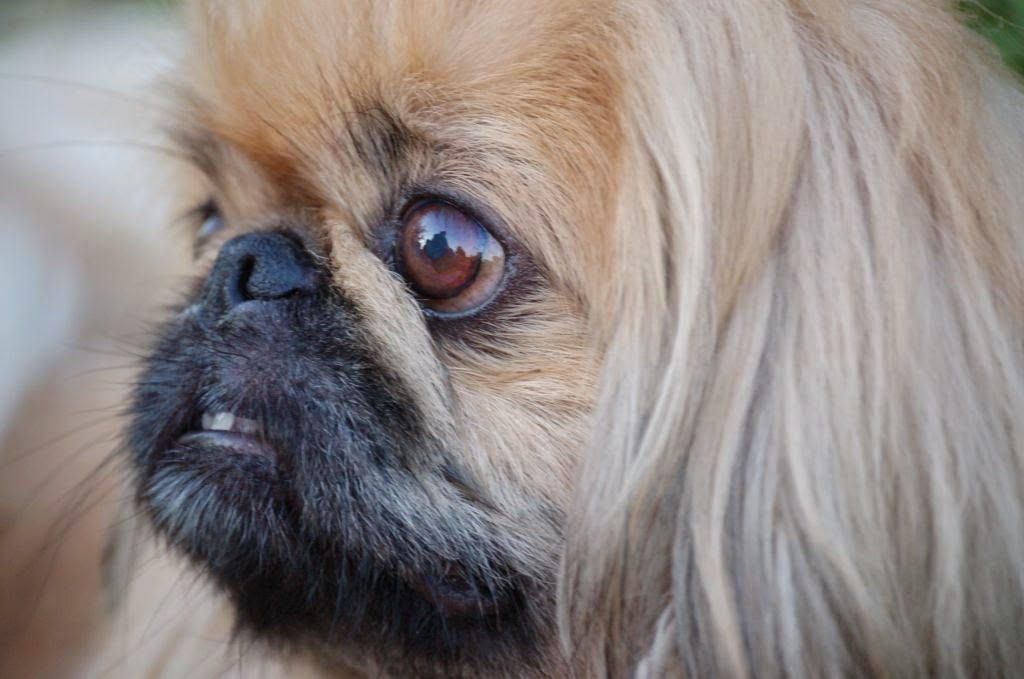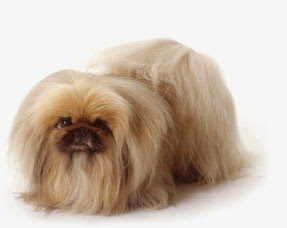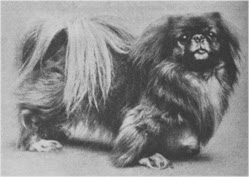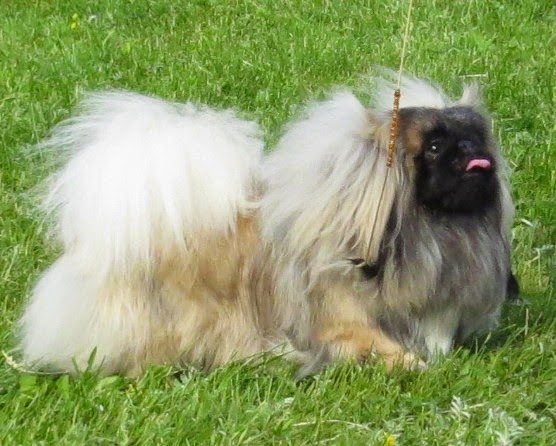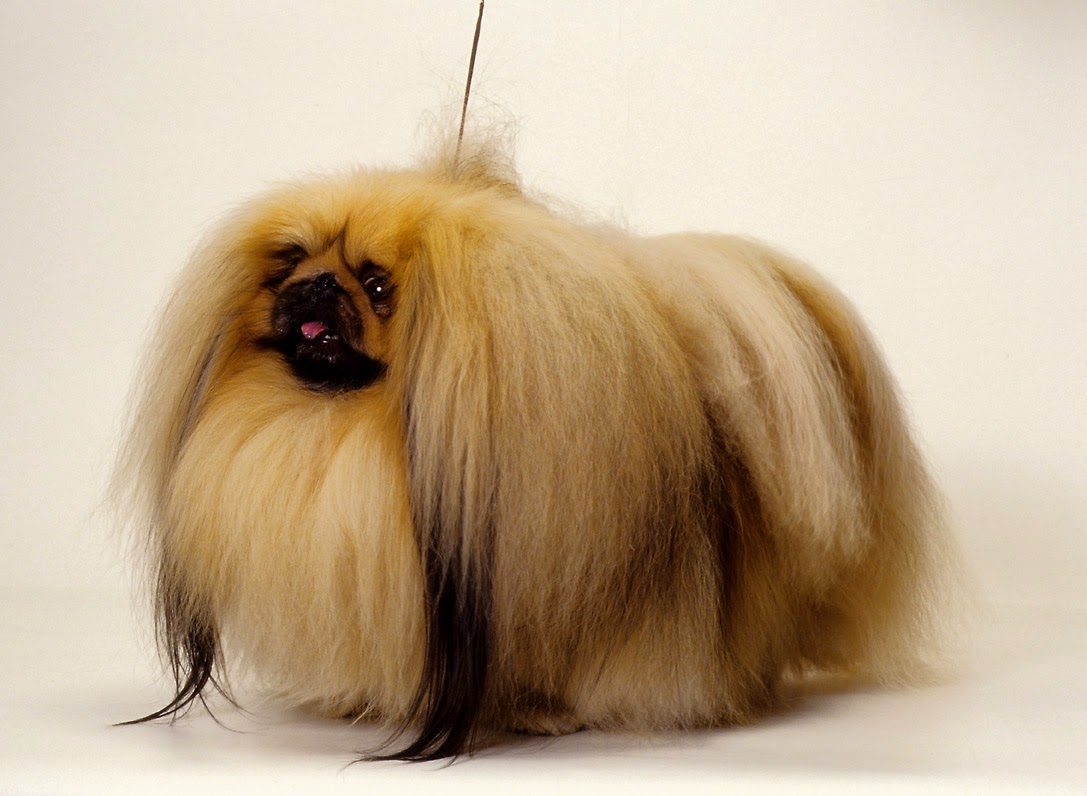- The Peke’s glamorous coat can come in all coat colors and markings, including parti-color (a color, plus white).
- The Pekingese is meant to suggest lionlike courage, boldness, and self-esteem.
- The Pekingese may look small, but he is solidly built and surprisingly heavy when lifted.
- This breed takes its name from Peking, as the capital of China used to be called.
Breed standards
AKC group: Toy
UKC Group: Companion Dog
Average lifespan: 14 – 18 years
Average size: 7 – 14 pounds
Coat appearance: Long, straight, coarse
Coloration: Varies
Hypoallergenic: No
Other identifiers: Small, compact body frame, “lion-like” appearance
History
The breed originated in China in antiquity. Recent DNA analysis confirms that the Pekingese breed is one of the oldest breeds of dog, one of the least genetically diverged from the wolf. For centuries, they could only be owned by members of the Chinese Imperial Palace.
During the Second Opium War, in 1860, the Old Summer Palace in Beijing was occupied by a contingent of British and French troops. The Emperor Xianfeng had fled with all of his court to Chengde. However, an elderly aunt of the emperor remained. When the British and French troops entered, she committed suicide. She was found with her five Pekingese mourning her death. They were removed by the Allies before the Summer Palace was burnt to the ground.
Lord John Hay took a pair, later called Schloff and Hytien, and gave them to his sister, the Duchess of Wellington, wife of Henry Wellesley, 3rd Duke of Wellington. Sir George Fitzroy took another pair, and gave them to his cousins, the Duke and Duchess of Richmond and Gordon. Lieutenant Dunne presented the fifth Pekingese to Queen Victoria of the United Kingdom, who named it Looty.
The Empress Dowager Cixi presented Pekingese to several Americans, including John Pierpont Morgan and Alice Lee Roosevelt Longworth, daughter of Theodore Roosevelt, who named it Manchu.
The first Pekingese in Ireland was introduced by Dr. Heuston. He established smallpox vaccination clinics in China. The effect was dramatic. In gratitude, the Chinese minister, Li Hongzhang presented him with a pair of Pekingese. They were named Chang and Lady Li. Dr. Heuston founded the Greystones kennel.
Around the turn of the century, Pekingese dogs became popular in Western countries. They were owned by such arbiters of fashion as Queen Alexandra of the United Kingdom, and Elsie de Wolfe, popular American interior decorator.
According to the 1948 publication Dogs In Britain, A Description of All Native Breeds and Most Foreign Breeds in Britain by Clifford LB Hubbard, the Sleeve Pekingese is a true miniature of the standard-sized dog, and was also known as the Miniature Pekingese. The name Sleeve Pekingese came from the custom of carrying these small dogs in the capacious sleeves of the robes worn by members of the Chinese Imperial Household. Hubbard indicated that this tradition appeared to be early Italian rather than Chinese, but its adoption by the Chinese Imperial Household led to dogs being bred as small as possible and to practices aimed at stunting their growth: giving puppies rice wine, holding new-borns tightly for hours at a time or putting the puppies into tight-fitting wire mesh waistcoats. These practices were apparently forbidden by the late Dowager Empress Tzu Hsi.
In Hubbard’s time, the term Sleeve was applied in Britain to a miniature Pekingese no more than 6–7 pounds in weight, often appearing to be only about 3–4 pounds. Mrs Flander’s Mai Mai weighed only a little over 4 pounds and many other breeders had bred true miniatures of a similar size. He noted that miniatures may appear in a litter bred from full-sized Pekingese and were exhibited in classes for dogs less than 7 pounds at the major dog shows in Britain. In 1946, the Sleeve Pekingese had a strong following with the most popular colours being cream and white, with white being considered particularly attractive. He illustrated the description with a white Sleeve Pekingese bred by Mrs Aileen Adam.
Personality
He may look foofy, but the Pekingese is a stand-up character who’s tougher and braver than his appearance suggests. The Peke’s regal dignity, self-importance, confidence, and stubborn streak all come together in a lively, affectionate, good-natured dog who’ll respect you if you respect him. He’s loyal to and protective of his people, barking in warning when strangers appear. Train him with firm, kind consistency, using positive reinforcements such as food rewards and praise. You will always succeed if you can persuade the Peke that doing something is his idea, not yours.
Temperament is affected by a number of factors, including heredity, training, and socialization. Puppies with nice temperaments are curious and playful, willing to approach people and be held by them. Choose the middle-of-the-road puppy, not the one who’s beating up his littermates or the one who’s hiding in the corner. Always meet at least one of the parents — usually the mother is the one who’s available — to ensure that they have nice temperaments that you’re comfortable with. Meeting siblings or other relatives of the parents is also helpful for evaluating what a puppy will be like when he grows up.
Like every dog, Pekingese need early socialization — exposure to many different people, sights, sounds, and experiences — when they’re young. Socialization helps ensure that your Peke puppy grows up to be a well-rounded dog. Enrolling him in a puppy kindergarten class is a great start. Inviting visitors over regularly, and taking him to busy parks, stores that allow dogs, and on leisurely strolls to meet neighbors will also help him polish his social skills.
Health
The Pekingese, which has an average lifespan of 13 to 15 years, is prone to minor health problems like elongated soft palate, patellar luxation, stenotic nares, Keratoconjunctivitis Sicca (KCS), trichiasis, corneal abrasions, disticiasis, and skin fold dermatitis. It also known to suffer from urolithiasis occasionally. This breed does not tolerate heat or anesthesia well. Additionally, Pekingese pups are often delivered by cesarean section.
Keeping the Pekingese coat healthy and presentable requires daily brushing, and a trip to the groomer every 8–12 weeks. One important thing for new owners to remember is that dogs intended as a house pet may be kept in a puppy cut which is much more low maintenance than a show cut. It is also important to remove dirt from the eyes daily, and from the creases on the face to prevent sores (hot spots). It is also necessary to keep and maintain the fur in the buttocks of the Pekingese clean and well groomed as the area is prone to soiling.
Due to their abundance of fur, it is important to keep the Pekingese cool. The breed is prone to having heatstroke when exposed to high temperature.
Peke legends
There are two origin stories for the Pekingese. The first is the most common, The Lion and the Marmoset:
A lion and a marmoset fell in love. But the lion was too large. The lion went to the Buddha and told him of his woes. The Buddha allowed the lion to shrink down to the size of the marmoset. And the Pekingese was the result.
The second, less-common, originating story is The Butterfly Lions:
A lion fell in love with a butterfly. But the butterfly and lion knew the difference in size was too much to overcome. Together they went to see the Buddha, who allowed their size to meet in the middle. From this, the Pekingese came.
Another legend says that the breed resulted from the mating of a lion and a monkey, getting its nobleness and coat from the former and its ungainly walk from the latter.
Because the Pekingese was believed to have originated from the Buddha, he was a temple dog. As such, he was not a mere toy. He was made small so that he could go after and destroy little demons that might infest the palace or temple. But his heart was big so that he could destroy even the largest and fiercest.
Exercise
Pekingese need a daily walk, where the dog is made to heel beside or behind the person holding the lead, as instinct tells a dog the leader leads the way, and that leader needs to be the human. Play will take care of a lot of their exercise needs, however, as with all breeds, play will not fulfill their primal instinct to walk. Dogs that do not get to go on daily walks are more likely to display behavior problems. They will also enjoy a good romp in a safe, open area off lead, such as a large, fenced-in yard. Get your Peke accustomed to the leash when it is still a puppy. Some owners have told me their Pekes will walk up to 4 miles on a nightly walk.
Grooming
The Pekingese has a long,
beautiful double coat with a thick mane on the neck and shoulders and profuse fringing or feathering on the ears, tail, legs and toes. Grooming this glamourous dog is not as difficult as it might appear, though. Regular care will keep the coat healthy and prevent the formation of mats or tangles, which are often the primary reason people think longhaired dogs are hard to care for. Your dog’s breeder is the best source for advice on caring for the coat, especially if you plan to show him, but the following tips will get you started.
The Pekingese coat may need to be brushed daily, every other day, or just a couple of times a week, depending on the individual dog. Mist the coat with water or a special coat conditioner and brush through it with a pin brush or natural bristle brush. Start at the front and work your way back, brushing small sections of hair at a time. Be sure you brush all the way down to the skin, and keep misting the coat to protect the hair from breaking.
When your Pekingese sheds, and he definitely will, even if only a little, use a slicker brush to remove the dead hair. Brushing and removal of loose hair encourages new coat growth.
If your Pekingese lives life as a beloved companion, there’s nothing wrong with trimming his coat to make it easier to care for. Ask a groomer to trim the feathering on the feet and legs so they don’t collect so much dust and dirt. You can even have your Peke given a lion trim in which the body is shaved smooth, leaving a mane around the head and a pom pom on the tip of the tail. If grooming costs are getting you down, learn to do it yourself. With practice, many people give their dogs trims that look perfectly nice and professional.
The rest is basic care. Trim the nails as needed, usually every week or two. Check the ears to make sure they are clean. Leave them alone if they are; use a cleaner recommended by your veterinarian if they look dirty or have excessive amounts of wax. Toy breeds such as the Pekingese are prone to periodontal disease because they have so many teeth crammed into their little mouth. Brush the teeth frequently with a vet-approved pet toothpaste for good overall health and fresh breath.
Living Conditions
Pekingese are good for apartment life. They are relatively inactive indoors and will do okay without a yard.
Is this breed right for you?
This friendly, loving and tiny breed makes a perfect fit for an apartment lifestyle. Pekingese require only moderate exercise and are perfectly happy playing indoor games. Due to their strong personalities, some Pekes may not do well with small children, as they thoroughly enjoy being the center of attention. This breed also does not do well in warm climates and shouldn’t be outdoors for extended periods of time. Potential owners should also be warned: Pekingese are known to snore. If you’re going for the best-in-show look, be ready to spend a lot of time and money on grooming. Pekes’ long locks need to be brushed on a regular basis to prevent matting, particularly the long and coarse top coat.
Children and other pets
A Pekingese is not a good choice for families with toddlers who may treat him roughly without meaning to. The Peke won’t tolerate being grabbed or poked and won’t hesitate to defend himself.
Always teach children how to approach and touch dogs, and always supervise any interactions between dogs and young children to prevent any biting or ear or tail pulling on the part of either party. Teach your child never to approach any dog while he’s sleeping or eating or to try to take the dog’s food away. No dog should ever be left unsupervised with a child.
Pekes prefer the company of other Pekingese, but with early socialization they can learn to get along with other dogs (and cats) and may even rule over dogs that are 20 times their size.
A Pekingese named Winnie lived in the Playboy mansion – she belonged to “Girls Next Door” star Bridget Marquardt. Winnie’s proper name is Wednesday, after the daughter from the “Addams Family” series. She shared space in the mansion with Marquardt’s cat, Gizmo.
A dream day in the life of a Pekingese
Getting groomed and pampered like the kings and queens they are, Pekes love nothing more than being the center of attention. They excel in social settings and their compact size make them the perfect breed to tote around. Treat this adorable pup like royalty with plenty of toys and treats and you’ll have a happy companion by your side.
